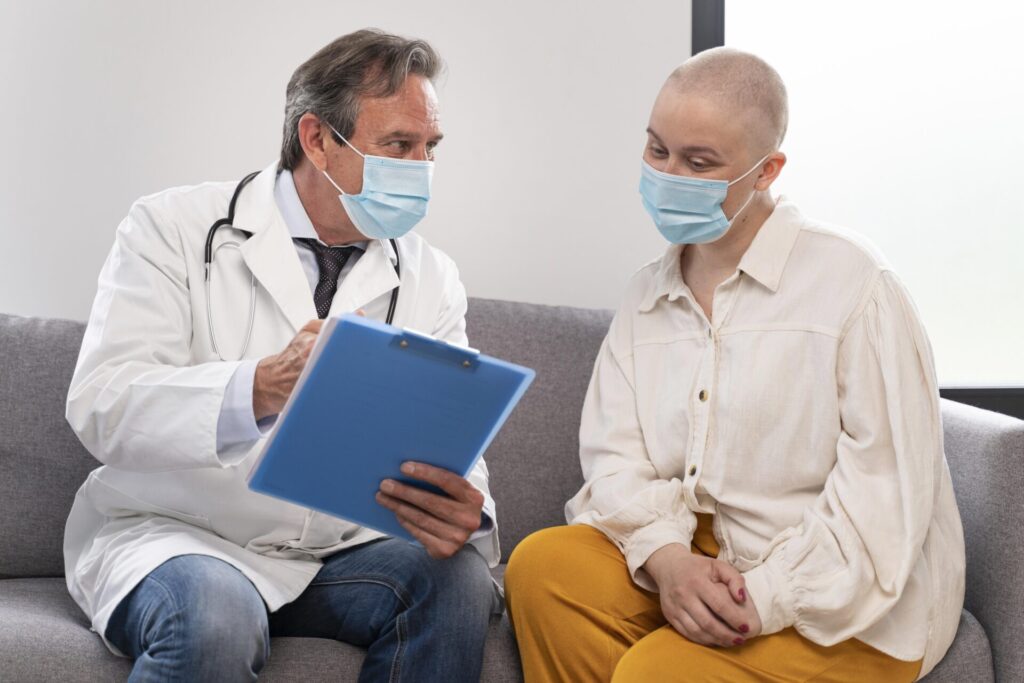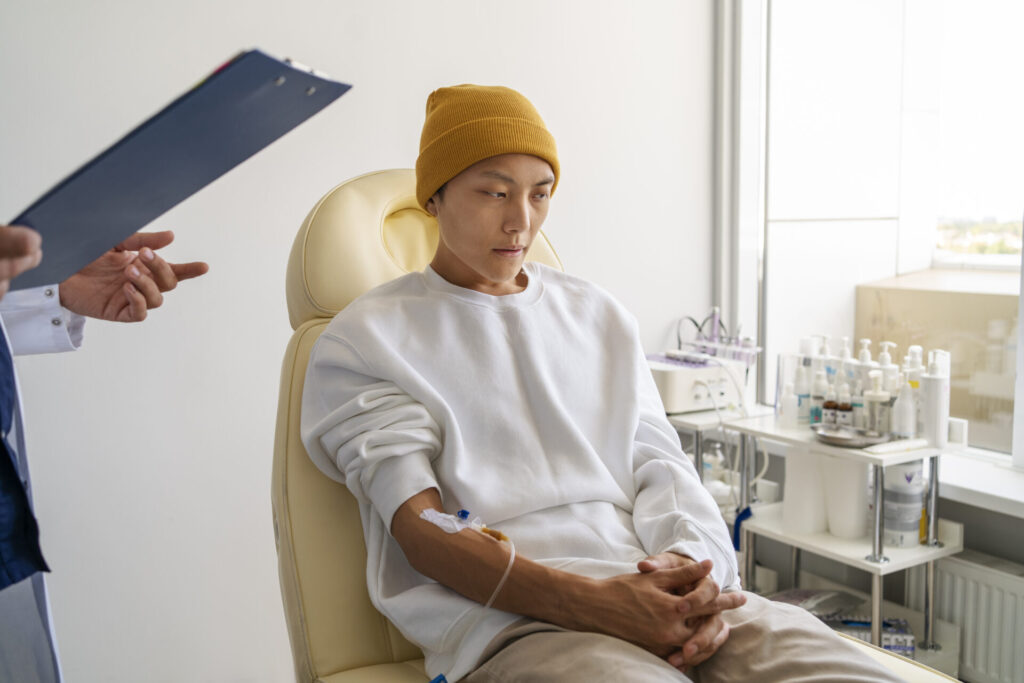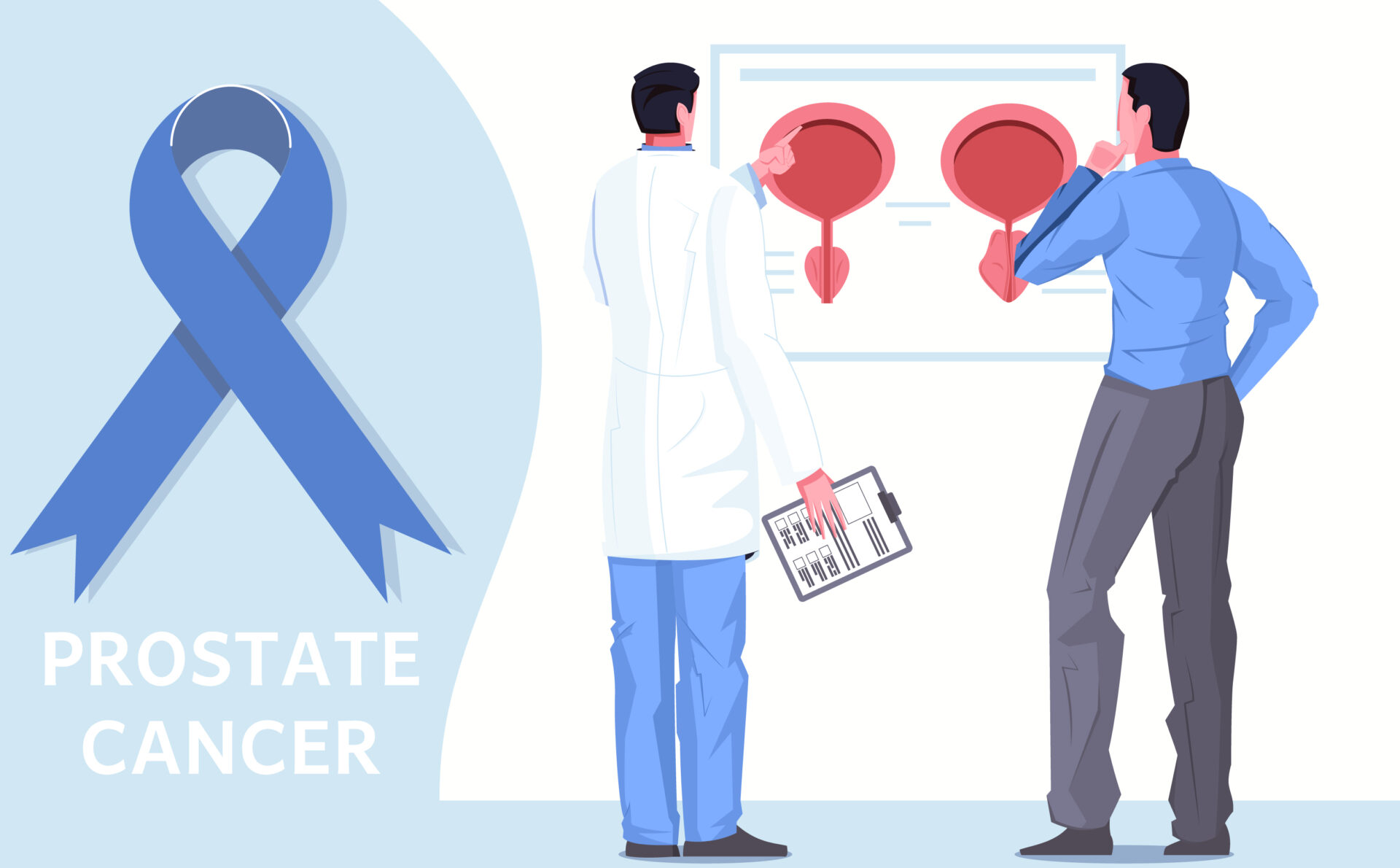Prostate Cancer: A Comprehensive Overview
Contents
- 1 Prostate Cancer: A Comprehensive Overview
Read DISCLAIMER
Discover in-depth information on prostate cancer, including risk factors, symptoms, diagnosis, treatments, and preventative measures. For better results, find out about new treatment options and early detection.
Introduction
The prostate gland, a walnut-shaped gland situated in front of the rectum and beneath the bladder in males, is where prostate cancer typically begins. As the producer of fluids that both nourish and transport sperm, the prostate gland is an essential component of the male reproductive system. About 15% of male cancer diagnoses are for prostate cancer, making it the second most frequent disease among males globally.
Risk Factors

Although the precise etiology of prostate cancer is still unknown, a number of risk factors have been shown to raise the likelihood of getting the illness. Among these are:
Age: Prostate cancer risk rises sharply with age. Men older than 65 are diagnosed with more than half of all prostate cancer cases.
Family History: Men who have a father or sibling with a prostate cancer diagnosis are more likely to have the illness themselves.
Race and Ethnicity: African American men are more likely than Caucasian men to have prostate cancer. In comparison to males of Caucasian descent, Hispanic guys are likewise more vulnerable.
Diet: Consuming a lot of processed foods and red meat may raise your risk of prostate cancer.
Symptoms
Prostate cancer may not show any symptoms when it is first diagnosed. However, if the illness worsens, a number of symptoms might appear, such as: • Urinary issues: Urinating often, especially at night; having trouble starting or halting the pee stream; and having blood in the urine are a few examples of these.
Pain: The hips, pelvis, and lower back might all experience pain.
Sexual dysfunction: This might include problems ejaculating, blood in the semen, or erectile dysfunction.
read more posts
Diagnosis

A effective course of therapy for prostate cancer requires early diagnosis. Prostate cancer can be identified using a number of tests, such as:
Digital rectal exam (DRE): A physician physically feels for anomalies in the prostate gland by passing a probe into the rectum.
PSA test: This test determines the blood level of prostate-specific antigen (PSA). Prostate cancer may be indicated by an increased level of PSA, a protein that the prostate gland produces.
Biopsy: To confirm the diagnosis of prostate cancer, a biopsy entails taking a little sample of prostate tissue for microscopic analysis.
Staging
Prostate cancer is staged to ascertain the disease’s progression after a diagnosis. Staging offers a prognostic prediction for the patient and aids in guiding therapy options. The TNM system, which takes into account the tumor’s size (T), the presence or absence of lymph node involvement (N), and the presence or absence of distant metastases (M), is the foundation for the prostate cancer staging system.
read more posts
Treatment

The course of treatment for prostate cancer is determined by the patient’s choices, age, general health, and disease stage. Prostate cancer treatment options include:
Active surveillance: This could be the best course of action for men with low-risk prostate cancer. In order to identify any indications of cancer development, active surveillance entails routinely checking the disease with PSA testing and biopsies.
Watchful waiting: This may be a suitable course of action for men with very low-risk prostate cancer. While watchful waiting does not require as much monitoring as active surveillance, early intervention is nevertheless advised in the event that the cancer begins to develop.
Surgery: Surgically removed, the prostate gland is the subject of a radical prostatectomy. Treatment for localized prostate cancer often entails this.
Radiation therapy: To destroy cancer cells, radiation therapy employs high-energy beams. For localized prostate cancer, radiation therapy can be used alone, in conjunction with hormone therapy or surgery, or as the only treatment.
Hormone treatment: Hormone therapy slows or stops the development of prostate cancer cells by reducing the body’s testosterone levels. For males with advanced prostate cancer, hormone treatment is frequently utilized.
read more posts
Prognosis
The patient’s age, general health, and the stage of the illness upon diagnosis all affect the prognosis for prostate cancer. Prostate cancer has an extremely high overall 5-year survival rate of nearly 95%. An individual’s chances of a successful result from prostate cancer are greatly increased by early identification and treatment.
Prevention

Although there is currently no known cure for prostate cancer, there are lifestyle modifications that may help lower the chance of contracting the illness. These consist of:
Preserving a healthy weight: Eating a well-balanced diet and getting regular exercise can support the maintenance of a healthy weight.
Reducing your intake of processed meals and red meat: Cutting back on these items may help reduce your chance of developing prostate cancer.
Consuming a diet high in fruits and vegetables: Eating a diet high in fruits and vegetables will help lower the risk of prostate cancer and offer vital nutrients.
read more posts
Conclusion
Men are particularly concerned about prostate cancer, which presents a range of risk factors, symptoms, diagnostic techniques, therapies, and preventative measures. It is important to emphasize that early diagnosis through routine screenings is crucial since prompt intervention is crucial to the treatability and favorable outcomes of this malignancy. The management of prostate cancer is still in its early stages, but with new research and a wide range of treatment choices, there is hope for better prognoses and higher quality of life for individuals who are diagnosed.
read more posts
Answers to the FAQs about prostate cancer:
1. What is prostate cancer?
Prostate cancer begins when abnormal cells in the prostate gland grow uncontrollably, forming a tumor. It’s the second most common cancer in men.
2. What are the 5 warning signs of prostate cancer?
Warning signs include urinary problems (frequency, weak stream), pain or discomfort in the pelvic area, erectile dysfunction, blood in urine or semen, and bone pain.
3. What is the longest someone has lived with stage 4 prostate cancer?
Survival rates vary widely, but cases of individuals living for years with stage 4 prostate cancer, with appropriate treatments and management, are documented.
4. How to prevent prostate cancer?
While prevention isn’t assured, maintaining a healthy weight, balanced diet, limiting red meat and processed foods, regular exercise, and avoiding smoking may reduce the risk.
5. How to check for prostate cancer at home?
At-home checks aren’t substitutes for professional diagnosis. Monitoring urinary symptoms, maintaining a healthy lifestyle, and being vigilant about any concerning changes may prompt consultations with healthcare providers.
6. How is prostate cancer diagnosed?
Diagnosis involves a digital rectal exam (DRE), PSA blood test, and biopsy for confirmation.
7. What are the signs of prostate cancer?
Signs may include urinary issues, pain in the lower back/pelvis, sexual dysfunction, and in advanced stages, bone pain or fractures.
8. What are the symptoms of prostate cancer?
Symptoms often include urinary problems, discomfort, sexual dysfunction, and bone pain in later stages.
9. What are signs of prostate cancer?
Signs encompass indicators like changes in urinary habits, persistent pain, sexual dysfunction, and unexplained bone pain.
10. How do you get prostate cancer?
Prostate cancer is caused by a combination of genetic, environmental, and lifestyle factors. Aging, family history, race, and diet play roles.
11. What foods kill prostate cancer cells?
Certain foods like cruciferous vegetables, tomatoes, green tea, and pomegranate juice contain compounds believed to have potential anticancer effects against prostate cancer cells.
12. How to check for prostate cancer?
Professional diagnosis includes a digital rectal exam, PSA blood test, and biopsy for confirmation.
13. What are the 4 stages of prostate cancer?
Stages range from localized (confined to the prostate) to advanced (spread to other organs), classified using the TNM system (Tumor, Node, Metastasis).
14. How common is prostate cancer?
Prostate cancer is a prevalent cancer in men, with millions diagnosed globally every year.
15. How many radiation treatments for prostate cancer?
Radiation treatment plans vary, but it typically involves several sessions spread over weeks, determined based on cancer stage and individual health.
16. What foods kill prostate cancer cells?
Certain foods like cruciferous vegetables, tomatoes, green tea, and pomegranate juice contain compounds believed to have potential anticancer effects against prostate cancer cells.
17. What is the most accurate test for prostate cancer?
No single test is definitive. Diagnosis often involves a combination of a digital rectal exam (DRE), PSA blood test, and biopsy.
18. What does prostate cancer feel like?
Sensations can vary, but pain, discomfort, urinary changes, and in later stages, bone pain or fractures may occur.
19. What causes prostate cancer?
The exact cause is unclear, but it’s linked to genetic mutations, aging, family history, race, and dietary factors.
20. What are symptoms of prostate cancer?
Symptoms include urinary issues, pain, sexual dysfunction, and in advanced stages, bone pain.
21. How to treat prostate cancer?
Treatments range from active surveillance to surgery, radiation therapy, hormone therapy, and chemotherapy, determined based on cancer stage and individual health.
22. What percentage of prostate biopsies are cancer?
Biopsies detect cancerous cells, but the percentage can vary widely based on the individual and the stage of cancer.
23. What are early signs of prostate cancer?
Early signs might include changes in urinary habits, discomfort, or subtle pain.
24. How long can you live with stage 4 prostate cancer with treatment?
Survival rates vary, and response to treatment plays a crucial role, but some individuals have lived for years with appropriate treatment.
25. What are the early signs of prostate cancer?
Early signs often involve urinary changes, discomfort, or subtle pain.
26. How to test for prostate cancer?
Professional diagnosis involves a digital rectal exam (DRE), PSA blood test, and biopsy for confirmation.
27. What is the success rate of radiation therapy for prostate cancer?
Success rates for radiation therapy vary depending on cancer stage, treatment plan, and individual response.
28. How is prostate cancer treated?
Treatments range from active surveillance to surgery, radiation therapy, hormone therapy, and chemotherapy, tailored to the individual’s needs.
29. Where does prostate cancer spread?
Prostate cancer often spreads to bones and nearby tissues, and in later stages, it may metastasize to other organs.
30. What causes prostate cancer?
Prostate cancer is multifactorial, influenced by genetics, age, race, diet, and environmental factors.
31. What are the risk factors for prostate cancer?
Factors include age, family history, race, diet, and lifestyle choices.
32. What symptoms might indicate prostate cancer?
Symptoms encompass urinary problems, pain in the lower back or pelvis, and sexual dysfunction.
33. How is prostate cancer diagnosed?
Diagnosis involves a digital rectal exam (DRE), PSA test, and biopsy for confirmation.
34. What treatment options are available for prostate cancer?
Treatments range from active surveillance and surgery to radiation therapy and hormone therapy, based on the cancer’s stage and patient preferences.
35. Can prostate cancer be prevented?
While no proven prevention method exists, maintaining a healthy weight, balanced diet, and reducing red meat consumption may help lower the risk.

Many thanks for sharing most of these wonderful discussions. In addition, the optimal travel as well as medical insurance plan can often eliminate those problems that come with travelling abroad. Some sort of medical emergency can quickly become very costly and that’s absolute to quickly set a financial load on the family finances. Setting up in place the best travel insurance program prior to leaving is worth the time and effort. Thanks
The articles you write help me a lot and I like the topic http://www.hairstylesvip.com
Thank you for your sharing. I am worried that I lack creative ideas. It is your article that makes me full of hope. Thank you. But, I have a question, can you help me?
I don’t think the title of your article matches the content lol. Just kidding, mainly because I had some doubts after reading the article.
Your point of view caught my eye and was very interesting. Thanks. I have a question for you.
I apologise, but, in my opinion, you commit an error. I suggest it to discuss. Write to me in PM.
https://the.hosting/
https://ping.space/
https://ufo.hosting/blog/kakuyu-operatsionnuyu-sistemu-vybrat-dlya-servera
sailboat rental bahamas
Your article helped me a lot, is there any more related content? Thanks!
https://auctionwheels.info/cars/scion/models/im/pagination/start
I think, that you are not right. I am assured. I can defend the position. Write to me in PM, we will communicate.
https://pastebin.com/u/findycarfr
Thank you for your sharing. I am worried that I lack creative ideas. It is your article that makes me full of hope. Thank you. But, I have a question, can you help me? https://www.binance.info/register?ref=P9L9FQKY
canadian virtual phone number
I am am excited too with this question.
I don’t think the title of your article matches the content lol. Just kidding, mainly because I had some doubts after reading the article.